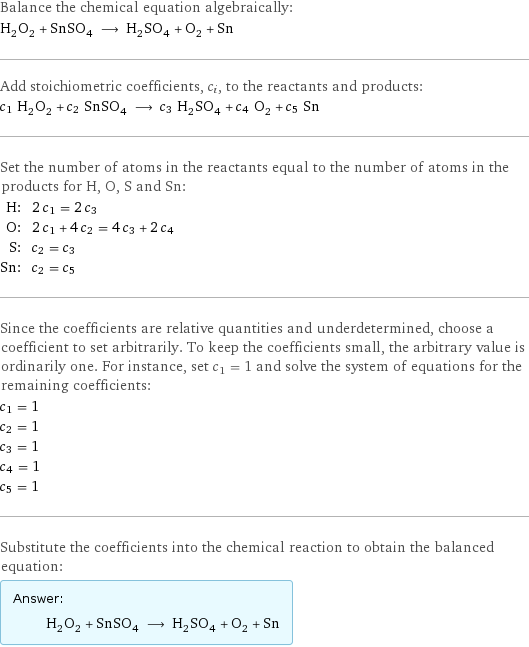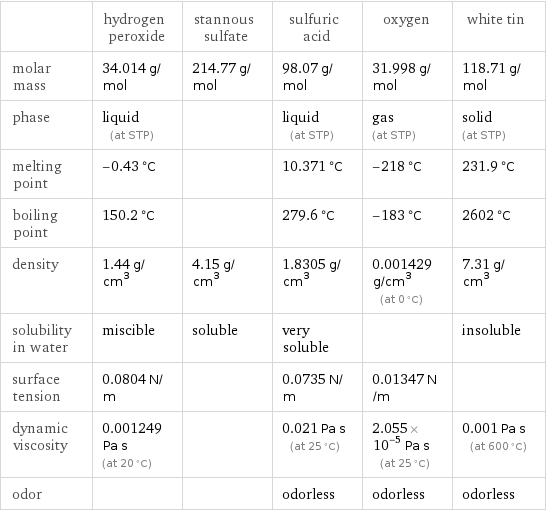Input interpretation

H_2O_2 hydrogen peroxide + SnSO_4 stannous sulfate ⟶ H_2SO_4 sulfuric acid + O_2 oxygen + Sn white tin
Balanced equation

Balance the chemical equation algebraically: H_2O_2 + SnSO_4 ⟶ H_2SO_4 + O_2 + Sn Add stoichiometric coefficients, c_i, to the reactants and products: c_1 H_2O_2 + c_2 SnSO_4 ⟶ c_3 H_2SO_4 + c_4 O_2 + c_5 Sn Set the number of atoms in the reactants equal to the number of atoms in the products for H, O, S and Sn: H: | 2 c_1 = 2 c_3 O: | 2 c_1 + 4 c_2 = 4 c_3 + 2 c_4 S: | c_2 = c_3 Sn: | c_2 = c_5 Since the coefficients are relative quantities and underdetermined, choose a coefficient to set arbitrarily. To keep the coefficients small, the arbitrary value is ordinarily one. For instance, set c_1 = 1 and solve the system of equations for the remaining coefficients: c_1 = 1 c_2 = 1 c_3 = 1 c_4 = 1 c_5 = 1 Substitute the coefficients into the chemical reaction to obtain the balanced equation: Answer: | | H_2O_2 + SnSO_4 ⟶ H_2SO_4 + O_2 + Sn
Structures

+ ⟶ + +
Names

hydrogen peroxide + stannous sulfate ⟶ sulfuric acid + oxygen + white tin
Equilibrium constant
![Construct the equilibrium constant, K, expression for: H_2O_2 + SnSO_4 ⟶ H_2SO_4 + O_2 + Sn Plan: • Balance the chemical equation. • Determine the stoichiometric numbers. • Assemble the activity expression for each chemical species. • Use the activity expressions to build the equilibrium constant expression. Write the balanced chemical equation: H_2O_2 + SnSO_4 ⟶ H_2SO_4 + O_2 + Sn Assign stoichiometric numbers, ν_i, using the stoichiometric coefficients, c_i, from the balanced chemical equation in the following manner: ν_i = -c_i for reactants and ν_i = c_i for products: chemical species | c_i | ν_i H_2O_2 | 1 | -1 SnSO_4 | 1 | -1 H_2SO_4 | 1 | 1 O_2 | 1 | 1 Sn | 1 | 1 Assemble the activity expressions accounting for the state of matter and ν_i: chemical species | c_i | ν_i | activity expression H_2O_2 | 1 | -1 | ([H2O2])^(-1) SnSO_4 | 1 | -1 | ([SnSO4])^(-1) H_2SO_4 | 1 | 1 | [H2SO4] O_2 | 1 | 1 | [O2] Sn | 1 | 1 | [Sn] The equilibrium constant symbol in the concentration basis is: K_c Mulitply the activity expressions to arrive at the K_c expression: Answer: | | K_c = ([H2O2])^(-1) ([SnSO4])^(-1) [H2SO4] [O2] [Sn] = ([H2SO4] [O2] [Sn])/([H2O2] [SnSO4])](../image_source/9cddc60b03f5ed37b6ed47d55037cb0b.png)
Construct the equilibrium constant, K, expression for: H_2O_2 + SnSO_4 ⟶ H_2SO_4 + O_2 + Sn Plan: • Balance the chemical equation. • Determine the stoichiometric numbers. • Assemble the activity expression for each chemical species. • Use the activity expressions to build the equilibrium constant expression. Write the balanced chemical equation: H_2O_2 + SnSO_4 ⟶ H_2SO_4 + O_2 + Sn Assign stoichiometric numbers, ν_i, using the stoichiometric coefficients, c_i, from the balanced chemical equation in the following manner: ν_i = -c_i for reactants and ν_i = c_i for products: chemical species | c_i | ν_i H_2O_2 | 1 | -1 SnSO_4 | 1 | -1 H_2SO_4 | 1 | 1 O_2 | 1 | 1 Sn | 1 | 1 Assemble the activity expressions accounting for the state of matter and ν_i: chemical species | c_i | ν_i | activity expression H_2O_2 | 1 | -1 | ([H2O2])^(-1) SnSO_4 | 1 | -1 | ([SnSO4])^(-1) H_2SO_4 | 1 | 1 | [H2SO4] O_2 | 1 | 1 | [O2] Sn | 1 | 1 | [Sn] The equilibrium constant symbol in the concentration basis is: K_c Mulitply the activity expressions to arrive at the K_c expression: Answer: | | K_c = ([H2O2])^(-1) ([SnSO4])^(-1) [H2SO4] [O2] [Sn] = ([H2SO4] [O2] [Sn])/([H2O2] [SnSO4])
Rate of reaction
![Construct the rate of reaction expression for: H_2O_2 + SnSO_4 ⟶ H_2SO_4 + O_2 + Sn Plan: • Balance the chemical equation. • Determine the stoichiometric numbers. • Assemble the rate term for each chemical species. • Write the rate of reaction expression. Write the balanced chemical equation: H_2O_2 + SnSO_4 ⟶ H_2SO_4 + O_2 + Sn Assign stoichiometric numbers, ν_i, using the stoichiometric coefficients, c_i, from the balanced chemical equation in the following manner: ν_i = -c_i for reactants and ν_i = c_i for products: chemical species | c_i | ν_i H_2O_2 | 1 | -1 SnSO_4 | 1 | -1 H_2SO_4 | 1 | 1 O_2 | 1 | 1 Sn | 1 | 1 The rate term for each chemical species, B_i, is 1/ν_i(Δ[B_i])/(Δt) where [B_i] is the amount concentration and t is time: chemical species | c_i | ν_i | rate term H_2O_2 | 1 | -1 | -(Δ[H2O2])/(Δt) SnSO_4 | 1 | -1 | -(Δ[SnSO4])/(Δt) H_2SO_4 | 1 | 1 | (Δ[H2SO4])/(Δt) O_2 | 1 | 1 | (Δ[O2])/(Δt) Sn | 1 | 1 | (Δ[Sn])/(Δt) (for infinitesimal rate of change, replace Δ with d) Set the rate terms equal to each other to arrive at the rate expression: Answer: | | rate = -(Δ[H2O2])/(Δt) = -(Δ[SnSO4])/(Δt) = (Δ[H2SO4])/(Δt) = (Δ[O2])/(Δt) = (Δ[Sn])/(Δt) (assuming constant volume and no accumulation of intermediates or side products)](../image_source/e845c121e03adae141c87621c1ff4ba1.png)
Construct the rate of reaction expression for: H_2O_2 + SnSO_4 ⟶ H_2SO_4 + O_2 + Sn Plan: • Balance the chemical equation. • Determine the stoichiometric numbers. • Assemble the rate term for each chemical species. • Write the rate of reaction expression. Write the balanced chemical equation: H_2O_2 + SnSO_4 ⟶ H_2SO_4 + O_2 + Sn Assign stoichiometric numbers, ν_i, using the stoichiometric coefficients, c_i, from the balanced chemical equation in the following manner: ν_i = -c_i for reactants and ν_i = c_i for products: chemical species | c_i | ν_i H_2O_2 | 1 | -1 SnSO_4 | 1 | -1 H_2SO_4 | 1 | 1 O_2 | 1 | 1 Sn | 1 | 1 The rate term for each chemical species, B_i, is 1/ν_i(Δ[B_i])/(Δt) where [B_i] is the amount concentration and t is time: chemical species | c_i | ν_i | rate term H_2O_2 | 1 | -1 | -(Δ[H2O2])/(Δt) SnSO_4 | 1 | -1 | -(Δ[SnSO4])/(Δt) H_2SO_4 | 1 | 1 | (Δ[H2SO4])/(Δt) O_2 | 1 | 1 | (Δ[O2])/(Δt) Sn | 1 | 1 | (Δ[Sn])/(Δt) (for infinitesimal rate of change, replace Δ with d) Set the rate terms equal to each other to arrive at the rate expression: Answer: | | rate = -(Δ[H2O2])/(Δt) = -(Δ[SnSO4])/(Δt) = (Δ[H2SO4])/(Δt) = (Δ[O2])/(Δt) = (Δ[Sn])/(Δt) (assuming constant volume and no accumulation of intermediates or side products)
Chemical names and formulas

| hydrogen peroxide | stannous sulfate | sulfuric acid | oxygen | white tin formula | H_2O_2 | SnSO_4 | H_2SO_4 | O_2 | Sn Hill formula | H_2O_2 | O_4SSn | H_2O_4S | O_2 | Sn name | hydrogen peroxide | stannous sulfate | sulfuric acid | oxygen | white tin IUPAC name | hydrogen peroxide | tin(+2) cation sulfate | sulfuric acid | molecular oxygen | tin
Substance properties

| hydrogen peroxide | stannous sulfate | sulfuric acid | oxygen | white tin molar mass | 34.014 g/mol | 214.77 g/mol | 98.07 g/mol | 31.998 g/mol | 118.71 g/mol phase | liquid (at STP) | | liquid (at STP) | gas (at STP) | solid (at STP) melting point | -0.43 °C | | 10.371 °C | -218 °C | 231.9 °C boiling point | 150.2 °C | | 279.6 °C | -183 °C | 2602 °C density | 1.44 g/cm^3 | 4.15 g/cm^3 | 1.8305 g/cm^3 | 0.001429 g/cm^3 (at 0 °C) | 7.31 g/cm^3 solubility in water | miscible | soluble | very soluble | | insoluble surface tension | 0.0804 N/m | | 0.0735 N/m | 0.01347 N/m | dynamic viscosity | 0.001249 Pa s (at 20 °C) | | 0.021 Pa s (at 25 °C) | 2.055×10^-5 Pa s (at 25 °C) | 0.001 Pa s (at 600 °C) odor | | | odorless | odorless | odorless
Units
